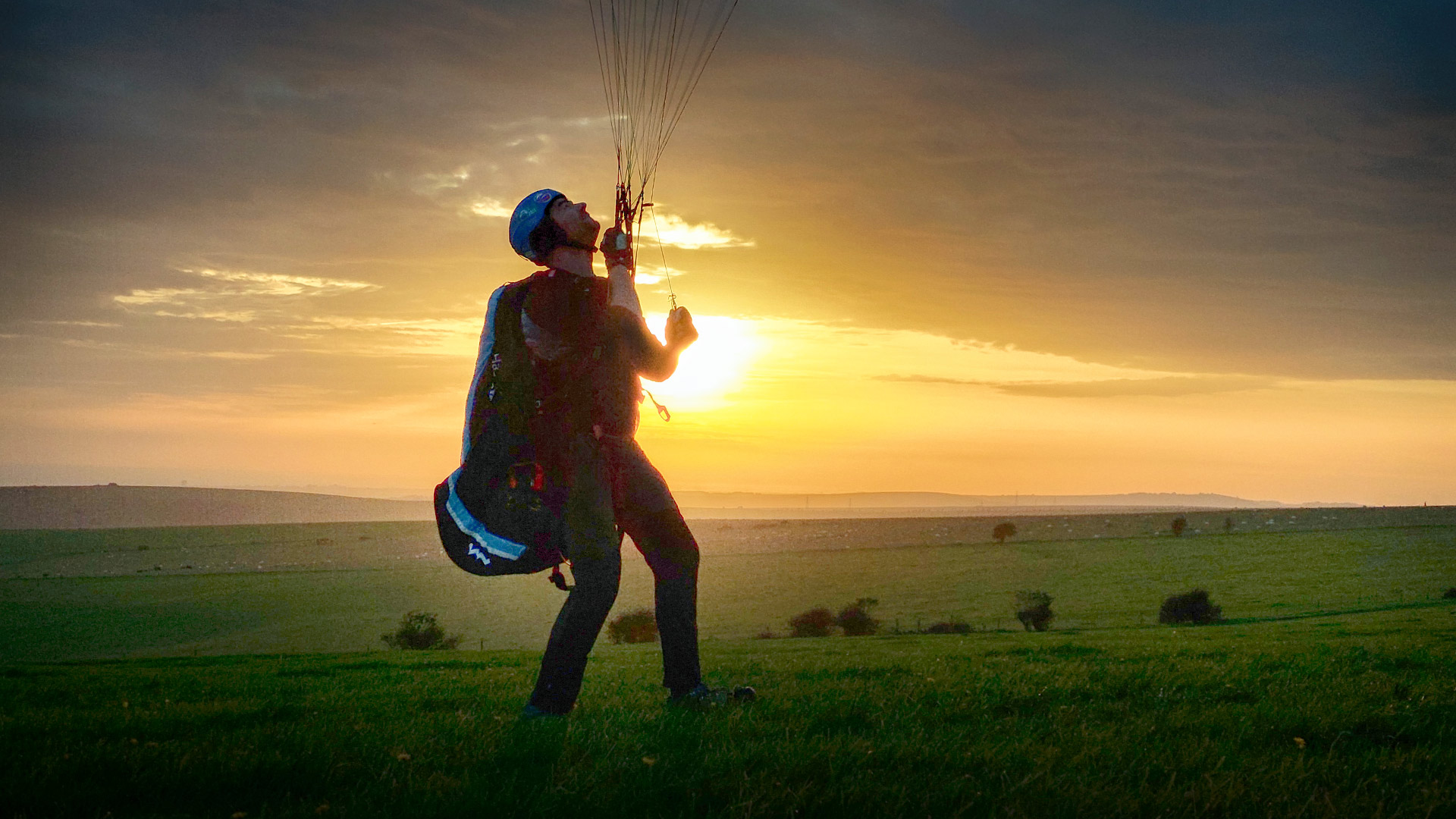There are things that you can do on the ground that really improve your paragliding. I have developed a set of exercises to train you in the key skills of ground handling. These tasks teach you about your brake inputs, body weight connection with the wing, and enhance your balance and muscle memory.
What you’re trying to achieve, is to improve your launch confidence, so when you get to the paragliding site you can really command your wing. That puts you in a strong mental place for flying.
How to set yourself up for success in ground handling
Find a sloping field that’s got clean air flow, not the school field in the town, because wind strong enough to kite in will become super turbulent. Try a beach or an exposed hilltop instead. Use your normal harness with protection, gloves and a helmet. In moderate conditions, use your paraglider. If you are just starting out or often have strong winds, a ground-trainer wing can be a great learning tool (it is very small and has reduced power). This is not the same as a ‘very old and knackered second hand wing’, which I don’t recommend because it launches badly and is usually too large, so just drags you around and erodes your confidence.
GROUND CONTROL TASKS
Spend 6 minutes on each task before moving to the next.
1. FORWARD LAUNCH
From a clean U shaped layout, do a gentle forward launch then keep the wing overhead and control it by moving your feet (a lot), and using the brakes (only a little). Lean through the risers and look straight ahead. This develops your feeling through the chest strap, which is important for understanding the wing during the next phase.
2. RUN:FLY
Get your weight on top (not behind) the chest strap, and work on progressively loading the wing to reach launch speed. Take long ‘slow motion’ steps, with your arms swept back, and feel the wing generate lift. Work on trying to fly as far as possible, which only happens when you coordinate your running speed with the wing speed.
3. CATCH THE PITCH
When the wing overshoots you it can cause the whole nose to collapse. This can be dangerous on a steep, rocky slope, when pilots often slow down from fear of the ‘edge’ which makes it worse. Practice shooting the wing ahead of you: run with the wing, then stop your feet and catch the wing with ‘hammer brakes’. Release brakes again straight away to keep it flying. Alternatively, use a pulse of bodyweight on the chest strap to make the wing overshoot.
4. SMOOTH TURN
Work on your turn transitions. Pull a little brakes, then turn to face the wing. Hold the wing in place, with a low balanced stance. Then turn to launch position. Kite for a moment, then turn back again. The wing should not be disturbed by your turn, so work on keeping your body movement smooth and your head height constant.
5. REVERSE MOVEMENT
Begin with a standard reverse launch, and work on keeping the wing overhead. Move your feet side to side to compensate for roll. Move your feet forward and back to manage the pitch and power. Use the brakes a little, to control yaw. Keep it overhead for as long as you can, then try to move around some obstacles to develop 3 axis control.
6. THE WORLD’S SLOWEST PULLUP
Control the speed of the ascent by how much you move towards the wing during the pullup. For a real challenge, try this facing forwards as well. The wing must continue to rise, but as slowly as you can make it do so, by removing all of the power from it. In stronger winds, you’ll have to run downwind faster.
7. HERE COMES THE DROP
Facing the wing, work on floating it gently down to the grass. Use the A’s to delay the drop, or re-energise the wing. This really puts you in touch with the power and moment that the wing engages the airflow.
8. STALL POINT!
The ability to kill the lift on the wing by aggressively pulling the brakes can help you greatly on a thermic launch site. Brake just enough to get the wingtips to bend back, then release again. Play at different angles, and also by moving downwind or upwind first, before braking.
9. SIDE TO SIDE
Being able to fly the wingtip close to the ground teaches you fine brake control and weight-shift balance. Get your wing tip to gently touch the ground on one side, then smoothly move it over to the other side. This position is very useful for moving around a site, and for reducing the upward pulling power in strong winds. It also teaches you spin point awareness and yaw control.
10. NEXT LEVEL
To wrap up your ground control hour, work on something you might have heard about, but never tried. Launching with a bunched wing. Aborting a twisted launch. Cobra launch. Flipping the wing over. Whatever you need to do, to push yourself in new ways, to develop your control and become a ground master.
To really master ground handling take the GROUND CONTROL COURSE. Everything you need to know to master your paraglider on the ground, with a special focus on strong wind ground control. There are detailed demonstrations and student training examples too. Everything is explained. Learn how to depower, kite uphill, cobra launch, master your wing with the A’s and C’s, and kill it effectively!


